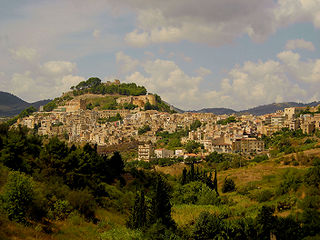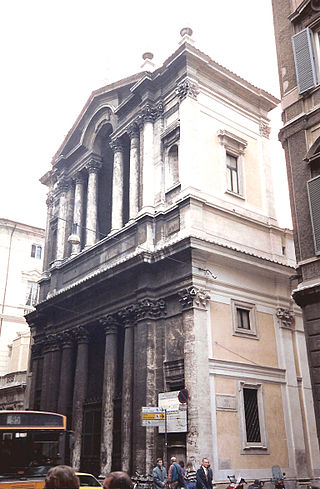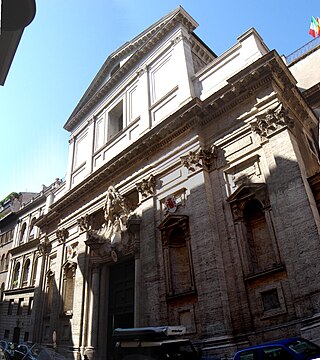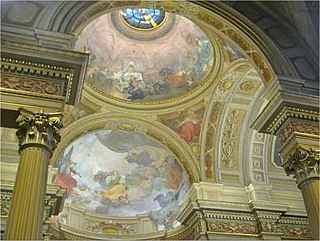
Calatafimi-Segesta, commonly known as simply Calatafimi, is a small town in the province of Trapani, in Sicily, southern Italy.

Regola is the 7th rione of Rome, Italy, identified by the initials R. VII, and belongs to the Municipio I. The name comes from Arenula, which was the name of the soft sand that the river Tiber left after the floods, and that built strands on the left bank.

The Parish Basilica of Santa Maria del Popolo is a titular church and a minor basilica in Rome run by the Augustinian order. It stands on the north side of Piazza del Popolo, one of the most famous squares in the city. The church is hemmed in between the Pincian Hill and Porta del Popolo, one of the gates in the Aurelian Wall as well as the starting point of Via Flaminia, the most important route from the north. Its location made the basilica the first church for the majority of travellers entering the city. The church contains works by several famous artists, such as Raphael, Gian Lorenzo Bernini, Caravaggio, Alessandro Algardi, Pinturicchio, Andrea Bregno, Guillaume de Marcillat and Donato Bramante.

Antonio di Benedetto Aquilo degli Aquili, known as Antoniazzo Romano, was an Italian Early Renaissance painter, the leading figure of the Roman school during the latter part of the 15th century. He "made a speciality of repainting or interpreting older images, or generating new cult images with an archaic flavor", in particular by very often using the gold ground style, which was unusual by this period.

Santa Maria dei Miracoli and Santa Maria di Montesanto are two churches in Rome.

Santa Maria in Via Lata is a church on the Via del Corso, in Rome, Italy. It stands diagonal from the church of San Marcello al Corso.

Agostino Ciampelli was an Italian painter of the Baroque period. He trained with Santi di Tito in Florence, and painted in Rome under Clement VIII, including a Crucifixion for Santa Prassede and a Saint Giovanni Gualberto in its sacristy; Angels on the walls above the choirstalls in the apse of Santa Maria in Trastevere; frescoes of the Stoning of Saint Vitale in San Vitale and further frescoes in the little church of Santa Bibiena; and The Visitation in Sant Stefano di Pescia. At the Basilica of San Giovanni in Laterano, Ciampelli frescoed the walls of the canons' sacristy, the "Sala Clementina".

Giuseppe Nicola Nasini was an Italian painter of the Baroque period, active in Rome and Tuscany.

The Spanish National Church of Santiago and Montserrat, known as Church of Holy Mary in Monserrat of the Spaniards is a Roman Catholic titulus church and National Church in Rome of Spain, dedicated to the Virgin of Montserrat. It is located in the Rione Regola, at the intersection of alleyway of Via della Barchetta and the narrow Via di Monserrato, with the facade on the latter street, about three blocks northwest of the Palazzo Farnese.

Santa Maria Maddalena dei Pazzi is a Renaissance-style Roman Catholic church and a former convent located in Borgo Pinti in central Florence, Italy.

The Church of Santa Maria dei Servi is a Romanesque style, Roman Catholic church in the Terzo of San Martino in the city of Siena, Tuscany, Italy.

Volterra Cathedral is a Roman Catholic cathedral in Volterra, Italy, dedicated to the Assumption of the Virgin Mary. It is the seat of the bishop of Volterra.

The Basilica of Santa Maria della Sanità is a basilica church located over the Catacombs of San Gaudioso, on a Piazza near where Via Sanità meets Via Teresa degli Scalzi, in the Rione of the Sanità, in Naples, Italy. The church is also called San Vincenzo or San Vincenzo della Sanità, due to the cult of an icon of San Vincenzo Ferrer, also called locally O' Monacone.

The church of Santa Maria Maddalena is found in central Bologna, Italy.

San Niccolò al Carmine, also called Santa Maria del Carmine is a Renaissance style, Roman Catholic church and monastery located in Pian dei Mantellini #30, near the corner of Via della Diana in the Terzo de Citta of Siena, region of Tuscany, Italy. The church now serves as the Oratory for the Contrada of Pantera. Across the street from the belltower is the Palazzo Celsi Pollini. North along Pian dei Mantellini, toward the Arco delle Due Porte, and on the same side of the street are a number of palaces built around what was once the Monastery of the Derelict Women: in order they are the Neoclassical Palazzo Incontri, the Palazzo Ravissa and the Palazzo Segardi.
Santa Maria delle Muratelle, or Santa Maria Annunziata delle Muratelle, is a 17th-century Roman Catholic church located on Via Saragozza #2 in Bologna, region of Emilia Romagna, Italy.
San Nicolò is a Neoclassical-style, Roman Catholic church located in the town of Isola Dovarese in the province of Cremona, region of Lombardy, Italy.

The Madonna Addolorata al Torresino, also called the Santa Maria del Pianto or Santa Maria del Torresino is a Roman Catholic parish church located in the city of Padua, region of Veneto, Italy.

The Church of Santa Maria Primerana is a Roman Catholic church located in the Tuscan town of Fiesole. It encloses the eastern end of Piazza Mino, next to the Praetorian Palace.

The Fontana del Pianto, also known as the Fontana di piazza delle Cinque Scole, is a monumental fountain located in the Piazza delle Cinque Scole in the rione of Regola in Rome.



















